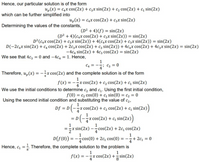
Calculus: Early Transcendentals
8th Edition
ISBN: 9781285741550
Author: James Stewart
Publisher: Cengage Learning
expand_more
expand_more
format_list_bulleted
Question
Kindly provide a detailed and thorough explanation about this example figure. It is only one example in two pictures.

Transcribed Image Text:Determine the general solution to (D² + 4)(f) = sin(2x) satisfying the initial condition:
f (0) = 0,
D(f(0)) = 0
Solution:
The related homogeneous ODE is (D² + 4)(f) = 0 with characteristic polynomial r2 + 4 = 0. The roots
are +2i (multiplicity 1). Thus, the general solution to the homogeneous solution is
uc(x) = c2 cos(2x) + c1 sin(2x)
Finding an annihilator for sin 2x, A(D) = (D - 2i)(D + 2i) = D² + 4. Thus, a solution to the original
equation also satisfies
(D² + 4)(D² + 4)f) = (D² + 4)(sin(2x))
(D² + 4)²(f) = 0
The characteristic polynomial is (r² + 4)² with root +2i (multiplicity 2). The corresponding solutions are
e0(x) cos(2x) = cos(2x); e0(x) sin(2x) = sin(2x)
xe0(x) cos(2x) = x cos(2x); xeº(x) sin(2x) = x sin(2x)
±2i

Transcribed Image Text:Hence, our particular solution is of the form
u,(x) = c4x cos(2x) + c3x sin(2x) + C2 cos(2x) + c, sin(2x)
which can be further simplified into
up(x) = c4x cos(2x)+ c3x sin(2x)
Determining the values of the constants,
(D² + 4)(f) = sin(2x)
(D² + 4)(c4x cos(2x) + c3x sin(2x)) = sin(2x)
D²(c4x cos(2x) + c3x sin(2x)) + 4(c4x cos(2x) + c3x sin(2x)) = sin(2x)
D(-2c,x sin(2x) + C4 cos(2x) + 2c3x cos(2x) + cz sin(2x)) + 4c,x cos(2x) + 4c3x sin(2x) = sin(2x)
-4c4 sin(2x) + 4c3 cos(2x) = sin(2x)
We see that 4c3 = 0 and -4c, = 1. Hence,
%3D
C4 =
Therefore, u, (x) = -x cos(2x) and the complete solution is of the form
1
-x cos(2x) + c2 cos(2x) + c, sin(2x)
We use the initial conditions to determine c2 and c . Using the first initial condition,
f(0) = c2 cos(0) + c; sin(0) = c2 = 0
Using the second initial condition and substituting the value of c2,
1
Df
D(-x cos(2x) + c2 cos(2x) + c; sin(2x))
%3D
= D
: cos(2x) + c, sin(2x)
1
=x sin(2x) –cos(2x) + 2c, cos(2x)
1
1
D(f(0)) = -cos(0) + 2c, cos(0) = -i+ 2c, = 0
Hence, c, = Therefore, the complete solution to the problem is
1
1
f(x) = -x cos(2x) + sin(2x)
Expert Solution
This question has been solved!
Explore an expertly crafted, step-by-step solution for a thorough understanding of key concepts.
Step by stepSolved in 2 steps with 2 images

Knowledge Booster
Similar questions
- Please help Which one correct??arrow_forwardB 3. 2. -10-9 -7-6 -3-2 -1 0 1 8. 9 10 -2 -3 -54 -6. -8. -9- -10 If the given triangle is reflected at x = -1, which quadrant would the image be located in? *arrow_forwardPlease do the questions d e f g Please do the questions d e f g Please do the questions d e f garrow_forward
- Answered: identify the triangle a X Home | bartleby Home | Lesson | Assessment Play x Owl Hub - Pastebin.com ô https://esw.edisonlearning.com/cds/index.html?sitelD=94442&userlD=414552&viewMode=false&schoolyear_id=531#/cp/lesson/lessonsplash/asses.. ... Geometry Part 3 [Competency Based] Junior Precile edisonlearning Geometry Part 3 [Competency Based] - Unit 3 Exam - EDCB.MA104.C Text-to-speech Question 1 2 4 5 6 7 2 of 7 Save Submit Classify the following triangle as right or not. Explain why it is or is not. 15 24 27 Use the paperclip button below to attach files. * Student can enter max 3500 characters B I U 1= 9:31 AM 4/22/2022 QuickNavarrow_forwardPerform the indicated operations. A. (5i-2j)+(-3i+2j) B. (i-3j)-(2i+j)arrow_forwardI need help with step 2arrow_forward
arrow_back_ios
arrow_forward_ios
Recommended textbooks for you
 Calculus: Early TranscendentalsCalculusISBN:9781285741550Author:James StewartPublisher:Cengage Learning
Calculus: Early TranscendentalsCalculusISBN:9781285741550Author:James StewartPublisher:Cengage Learning Thomas' Calculus (14th Edition)CalculusISBN:9780134438986Author:Joel R. Hass, Christopher E. Heil, Maurice D. WeirPublisher:PEARSON
Thomas' Calculus (14th Edition)CalculusISBN:9780134438986Author:Joel R. Hass, Christopher E. Heil, Maurice D. WeirPublisher:PEARSON Calculus: Early Transcendentals (3rd Edition)CalculusISBN:9780134763644Author:William L. Briggs, Lyle Cochran, Bernard Gillett, Eric SchulzPublisher:PEARSON
Calculus: Early Transcendentals (3rd Edition)CalculusISBN:9780134763644Author:William L. Briggs, Lyle Cochran, Bernard Gillett, Eric SchulzPublisher:PEARSON Calculus: Early TranscendentalsCalculusISBN:9781319050740Author:Jon Rogawski, Colin Adams, Robert FranzosaPublisher:W. H. Freeman
Calculus: Early TranscendentalsCalculusISBN:9781319050740Author:Jon Rogawski, Colin Adams, Robert FranzosaPublisher:W. H. Freeman
 Calculus: Early Transcendental FunctionsCalculusISBN:9781337552516Author:Ron Larson, Bruce H. EdwardsPublisher:Cengage Learning
Calculus: Early Transcendental FunctionsCalculusISBN:9781337552516Author:Ron Larson, Bruce H. EdwardsPublisher:Cengage Learning

Calculus: Early Transcendentals
Calculus
ISBN:9781285741550
Author:James Stewart
Publisher:Cengage Learning

Thomas' Calculus (14th Edition)
Calculus
ISBN:9780134438986
Author:Joel R. Hass, Christopher E. Heil, Maurice D. Weir
Publisher:PEARSON

Calculus: Early Transcendentals (3rd Edition)
Calculus
ISBN:9780134763644
Author:William L. Briggs, Lyle Cochran, Bernard Gillett, Eric Schulz
Publisher:PEARSON

Calculus: Early Transcendentals
Calculus
ISBN:9781319050740
Author:Jon Rogawski, Colin Adams, Robert Franzosa
Publisher:W. H. Freeman


Calculus: Early Transcendental Functions
Calculus
ISBN:9781337552516
Author:Ron Larson, Bruce H. Edwards
Publisher:Cengage Learning